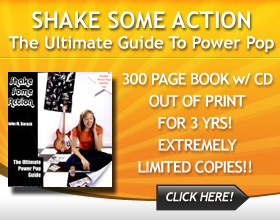An excerpt from the forthcoming BRIEF HISTORY OF JAZZ/ROCK by Mike Baron. It may not be power pop, but it’s good music and it will be good! ENJOY!
CHAPTER 18 “The Hook”
Music writers are always referring to a song’s hook, that sweet release that comes after the tension of the bridge. Tension and release is the foundation of all art, particularly the performing arts. There is much misunderstanding of what actually constitutes a hook.
From Wikipedia: A hook is a musical idea, a passage or phrase, that is believed to be appealing and make the song stand out. Hooks are “meant to catch the ear of the listener” (Covach 2005, p.71). Hooks generally apply to popular music, especially rock music and pop music subgenres such as dance music.
A hook can, in general, be either melodic or rhythmic, and often incorporates the main motif for a piece of music. Characteristics of a melodic hook include skips in the tonal line; however, details of what makes a tune “catchy” are difficult to describe. A rhythmic hook can be equally catchy by employing syncopation or other devices, but there are still examples of rhythmic hooks which are very straightforward.
Hooks are often used in music research by radio stations and record companies to gauge the popularity of various songs.
In song, hooks usually come at the end of the chorus, or lead into it, making the lyrics come to the height or “point” of the song.
John Davis, a founding member of the White Trash Blues Band and the Velvet Light Trap, says, “In general, I would say all forms of commercial entertainment need a hook to grab the audience, something that makes that particular book, movie, or song stand out from the rest. At the same time, the most common hooks are sex and violence. Would Beyonce, or Lady Ga Ga be so popular if they weren’t so good looking? Would rappers like 50 Cent be so popular without the level violence in their songs?
“Musically, a hook can be many things, a lyric, a horn riff, a key change, a solo, a beat, etc. You would need to look at each particular song (or music video) and ask yourself what is the particular hook of that song.”
Bill Champlin says, “It’s usually the Chorus of the song which repeats regularly. Sometimes it’s a handclap in the right place, but that’s more of an A&R or DJ definition.”
Phil Davis (no relation to John,) co-founder of Firetown, describes a hook as, “A song lyric, rhythm riff or melodic line, usually, repetitive, that ‘hooks’ the listener.”
Bruce Brodeen, chief cook and bottle washer for Not Lame Records and Rockandrolltribe, says, “The sticky, subconscious part of a song’s DNA that attaches itself to the brain’s memory stem and will not let go until it is acknowledged and
enjoyed by the music lover at a manifest, conscious level.”
Ben Sidran (www.bensidran.com,) a bonaroo jazz pianist who wrote “Space Cowboy” for the Steve Miller Band (of which he was a member) says, “A hook is the payoff, the point, the spear to the heart, the worm in the ear, the woman in the back booth, something so simple you can whistle along with it before it ends, the rubber meeting the road, the reason for the whole affair … otherwise, it ain’t a hook.”
Mark the airline pilot says, “The song ‘Killing Floor’ by Albert King (which appears on The Electric Flag: A Long Time Comin’) is a 12 bar Blues. It has a great ascending guitar riff that plays in the first measure, and then repeats in every measure of the song. That ascending riff (doubled by the bass) is the hook for that song. It repeats itself over and over, and “is” the song. I can’t remember many of the words, but I can play that hook in my sleep.
“The Blues Standard “Kansas City” has a very recognizable hook, the melody. Sing to yourself:
1 1 1 1
“I’m Going to Kansas City, Kansas City here I come,” (melodic response, usually guitar)
4 4 1 1
I’m going to Kansas City, Kansas City here i come” (another response, usually unchanged)
5 4 1 1
they got crazy little women, god um gonna get me one (turnaround)
“The melodic line “I’m going to Kansas City” is the songs main hook. It repeats itself through the call and the response. Everyone recognizes it. It more or less dominates the first 8 bars and in this song is the most recognizable feature, therefore the hook. On the 5 is a line that is rhythmically the same but melodically different in this song . It goes “they got crazy little women” over the 5 chord. and “God I’m gonna” over the 4 chord, which is melodically similar to the line over the 5, and then finishes with two measures of the one chord. the 5 chord is just a recognizable part of the blues standard that signals that you are starting the last 4 bar movement of the song, and getting ready to repeat the 12 bars over again…..and again……and again. It has no significant correlation with a hook. The hook could be placed over the 5 chord, probably a horn based riff (or hook if you will)
“When you thiink of a “guitar or instrumental hook”, look at the intro riff to “Mary had a Little Lamb”. SRV’s Guitar riff at the begining of the song, 1st half pre-measure, or count-in is his “Signature Hook”
Fair enough, but not far enough. For me, you can’t have a hook unless a song has at least three chords. One and two chord songs just don’t cut it. The hook is caused by a series of chords that demand resolution–they create a tipping point, an untenable sound, that can only be resolved by a chord that feels right to the ear. Wiki is right that the hook usually comes at the end of the chorus but not always. Let’s look at a couple Beach Boys songs for their hook.
“I Get Around” is pretty straightforward and states the hook right out of the gate. But it doesn’t become the hook until after the soaring chorus. First we hear the chorus beginning with “Round round get around I get around,” then the song breaks into the tonic. “I’m gettin bugged driving up and down the same old strip/I gotta find a new place where the kids are hip.” Second chorus. Then comes a repeat of the chorus but this time with a bridge that nudges the song up a chord: “I’m a real cool head, I’m making real good bread.” There follows a traditional Beach Boys doo-wop leading back to the chorus, “Round round get around I get around.”
“Good Vibrations,” which writer Brian Wilson called a “pocket symphony,” begins with a heavenly chorus that almost sighs, “I love the colorful clothes she wears, and the way the sunlight plays upon her hair…” There’s two chords right there plus the next verse. The hook is, “I’m pickin’ up good vibrations/She’s giving me excitations…” See how it neatly resolves the tension created by the ethereal yearning of the first two chords? That’s a hook!
After reading the above three paragraphs Mark the airline pilot said, “There are two rigidly flexible rules in music.
“1. To create tension do one of the following: create a phrase or pitch movement that is ascending in pitch (scale, arpeggio, glissando on a piano, violin or pennywhistle.) A descending pitch movement results in resolution. Increase volume or intensity and you get tension. Reduce volume or intensity and you get resolution (fff to ppp.) Play a pitch that is dissonant over a chord movement and you get tension. Resolve that to a consonant pitch and you get resolution. “Maria, I just met a girl named Maria” goes from major to a dissonant tritone, then resolves.
“2. Once a rule is thoroughly understood, it can be thoroughly broken! This is original. Think of Tension as an event that breaks normality. You are eating corn on the cob. Normal, enjoyable summertime thing. Suddenly you get a big kernel of corn stuck between your teeth. Dissonant, tension-building event. Normalcy is broken and you want it back. Get a piece of floss and remove the kernel. Release! You feel great. The release of tension may even make you feel better than you did a few minutes earlier before the errant piece of corn added dissonance to your moment!!
“Musicians think in phrases. Songwriters think in “hooks.” A trumpet player being coached prior to an important audition may be told to watch his phrasing, not his “hooks.” Songwriters like Burt Bacharach write phrases which are intended to get our attention. It is assumed that when Burt writes a phrase, or song, he automatically puts tension and release into the phrase.
“Rests in music are another example. When coaching my sons on their instruments, I have them slowly play the phrase, then exhale during the rests to make sure that the emptiness is recognized and emphasized. take a 4/4 measure : one-and-two-and-three-and-four
“Put rests on the upbeats, (the and’s) and you have a resolving march. You feel good like Souza! Life make perfect sense. Put the rest on the down beat (one-AND-two-AND-three-AND-
“Tension and resolution are very subjective, Your argument is that a sensation is a hook is interesting.”
So I hope that clears things up.



